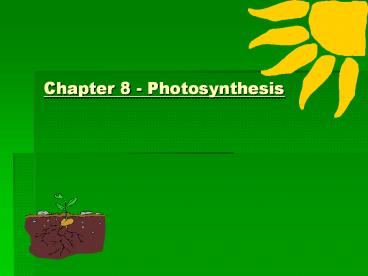Chapter 8 - Photosynthesis - PowerPoint PPT Presentation
1 / 29
Title:
Chapter 8 - Photosynthesis
Description:
... enters the cell from the atmosphere and undergoes a process called the Calvin Cycle ... cellular respiration occurs ... Photosynthesis and Respiration ... – PowerPoint PPT presentation
Number of Views:102
Avg rating:3.0/5.0
Title: Chapter 8 - Photosynthesis
1
Chapter 8 - Photosynthesis
2
Overview of Photosynthesis and Respiration
1. SUN
2. LIGHT ENERGY
3. PHOTOSYNTHESIS
5. RESPIRATION
6. ATP (CELL ENERGY)
4. CHEMICAL ENERGY
3
Energy Formation in Cells
Organic Compounds Oxygen
ATP
Energy for Life
Carbon Dioxide Water
ADP and P
4
Overview of Energy Formation
- Plants use sunlight to make food (Carbohydrates,
sugars, etc) This is stored energy though - Then cellular respiration occurs in the
mitochondria which takes the food and breaks it
down into usable energy, or ATP
5
What is ATP?
- Adenosine triphosphate- a chemical compound that
can store and release energy
6
How does ATP work?
- The energy in ATP lies in the bond between the
2nd and 3rd phosphate - If you break the bond and release the phosphate
energy is released which leaves you with ADP - If you add a phosphate to ADP you store energy
Energy
7
Where does it occur?
- In plants that are able to capture sunlight to
make their own food (aka autotrophs.) - The actual process occurs inside a cells
chloroplasts.
8
What does it need?
- CARBON DIOXIDE (CO2)
- WATER (H20)
- SUNLIGHT
9
What happens? (photosynthesis equation)
Water
Carbohydrates
6CO2
6H2O
ENERGY
C6H12O6
6O2
Sunlight
Carbon Dioxide
Oxygen
10
How does happen?
- The process of photosynthesis does not happen all
at once. It is a very long process that is broken
into 3 stages.
11
Stage 1 Light Reactions
- Light is absorbed from the sun by the
chloroplasts. - H2O is taken into the cell as well.
- The light energy is used to split H20 into 3
separate parts (H, O2, and electrons.)
12
How does it work?
- Inside the chloroplasts are disk-shaped
structures called thylakoids that contain
different pigments.
13
How does it work?
- Pigments do the actual absorbing of light.
- a) Chlorophylls absorb red and blue light
- (produce green colors)
- b) Carotenoids absorb other colors
- (produce yellow and orange colors)
14
(No Transcript)
15
How does it work?
- Once the sunlight is captured it is used to split
water (H20) into Hydrogen (H), Oxygen gas (O2),
and free electrons. - Oxygen gas (O2) is free to leave the plant and
this is what animals use to breathe.
16
Stage 2 Energy Storage
- Free electrons are passed from thylakoid to
thylakoid until they reach an ADP molecule and
turn it into an ATP. - Hydrogen (H) molecules are passed from protein to
protein until they reach a NADP molecule and
then they become an NADPH.
17
How does it work?
- As electrons continuously get passed on this
process is known as the electron transport chain.
18
Stage 3 Dark Reactions
- The newly formed ATP and NADPH power the
formation of carbohydrates, sugars, and starches. - This is done by using CO2 as the starting
material.
19
How does it work?
- Carbon Dioxide (CO2) enters the cell from the
atmosphere and undergoes a process called the
Calvin Cycle which creates simple sugars.
20
Step 1
- A Carbon Dioxide molecule is joined to a 5-carbon
compound called RuBP (ribulose bisphosphate) to
create a 6-carbon compound.
21
Step 2
- The newly formed 6-carbon compound immediately
splits into two 3-carbon compounds.
22
Step 3
- One of the new 3-carbon compounds is used to make
the initial 5-carbon compound that originally
joined to the Carbon Dioxide.
23
Step 4
- The second 3-carbon compound is used to make
carbohydrates, sugars, and starches.
24
(No Transcript)
25
Summary of Stages
Things used Things made
Stage 1 Light and H2O O2, H, and electrons
Stage 2 H and electrons ATP and NADPH
Stage 3 ATP, NADPH, and CO2 Carbohydrates, sugars, starches
26
Factors that affect it?
- Light intensity
- Amount of CO2 available
- Temperature
- If any of these factors increase the
photosynthesis process also increases and vice
versa.
27
Photosynthesis
H2O
CO2
Energy
ATP and NADPH2
Which splits water
Light is Adsorbed By Chlorophyll
Calvin Cycle
ADP NADP
Chloroplast
Used Energy and is recycled.
O2
C6H12O6
Light Reaction
Dark Reaction
28
- Photosynthesis
- Capturing Energy from the Sun
- Using energy to make ATP and NADPH
- Using ATP and NADPH to make carbohydrates,
sugars, and starches
Light Dependent Reactions Light Independent
Reactions (Calvin Cycle)
29
Any Questions?
- Education is light, lack of it darkness.
- --Russian Proverb
- Education is the movement from darkness to
light. --Bloom































